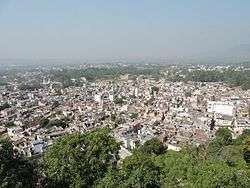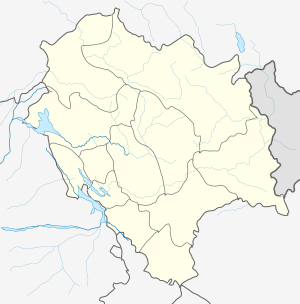Nalagarh
Nalagarh is a city and a municipal committee in Solan district in the Indian state of Himachal Pradesh.
Nalagarh | |
|---|---|
city | |
 View of city from the Palace/Heritage Resort Nalagarh | |
 Nalagarh Location in Himachal Pradesh, India  Nalagarh Nalagarh (India) | |
| Coordinates: 31.05°N 76.72°E | |
| Country | |
| State | Himachal Pradesh |
| Population (2011) | |
| • Total | 10,708 |
| • Rank | 15 in HP |
| Languages | |
| • Official | Hindi |
| Time zone | UTC+5:30 (IST) |
| Vehicle registration | HP HP-12 |
Geography
| Princely state |
|---|
| Individual residencies |
|
| Agencies |
|
| Lists |
Nalagarh is a gateway to Himachal Pradesh in North India, 300 km of north Delhi and 60 km from Chandigarh.
History
The Fort of Nalagarh was built in 1421 during the reign of Raja Bikram Chand on a hillock at the foothills of the mighty Himalayas. It affords a panoramic view of the Shivalik hills beyond the Sirsa river and gave its name to the state. Nalagarh enjoyed indirect rule during the British Raj as a non-salute state.
In the early twentieth century, Nalagarh State was one of the Simla hill states, under the government of Punjab.[1] The country was overrun by Gurkhas for some years before 1815, when they were driven out by the British, and the raja was confirmed in possession of the territory. Grain and opium were the main agricultural products.[2]
Rulers
| Period | Raja | Death |
|---|---|---|
| 1618 - 1701 | Dharm Chand | |
| 1701 - 1705 | Himmat Chand | |
| 1705 - 1761? | Bhup Singh | |
| 1761? - 1762 | Man Chand | (d. c.1762) |
| 1762 - 1788 | Gaje Singh | |
| 1788 - 1803 | Ram Saran Singh (1st time) | (b. c.1762 - d. 1848) |
| 1803 - 1815 | occupied by Nepal | |
| 1815 - 1848 | Ram Saran Sungh (2nd time) | (s.a.) |
| 1848 - 1857 | Bije Singh | (d. 1857) |
| 1857 - 15 Jan 1860 | interregnum | |
| 15 Jan 1860 - Dec 1876 | Agar Singh | (b. 1804 - d. 1876) |
| 16 Dec 1876 - 18 Sep 1911 | Ishri Singh | (b. 1836 - d. 1911) |
| 18 Sep 1911 - 1946 | Jogindra Singh | (b. 1877 - d. 1946) |
| 1946 - 15 August 1947 | Surendra Singh (b. 1922 - d. 1971) |
Governance
Nalagarh is a municipal council with 9 wards. Nalagarh area touches the areas of Ropar and Anandpur Sahib of Punjab.
Demographics
As of 2001 India census,[5] Nalagarh had a population of 9,433. Males constitute 54% of the population and females 46%. Nalagarh has an average literacy rate of 76%, higher than the national average of 59.5%: male literacy is 80%, and female literacy is 72%. 12% of the population is under 6.
In the 1961 Census of India, 78.4% of the Nalagarh tehsil of the then Ambala district registered as Hindi-speaking, 14.8% as Punjabi-speakers and 6.4% as Pahari-speaking.
| Rank | Language | 1961 census[6] |
|---|---|---|
| 1 | Hindi | 78.4% |
| 2 | Punjabi | 14.8% |
| 3 | Pahari unspecified | 6.4% |
| 4 | Other | 0.4% |
According to 2011 census[7], the Nalagarh Municipal Council has population of 10,708 of which 5,739 are males while 4,969 are females. Children age 0-6 number 1296 or 12.10%. The Female Sex Ratio is 866 against state average of 972. The Child Sex Ratio is around 914 compared to Himachal Pradesh state average of 909. Literacy rate is 90.03 % higher than state average of 82.80 %. Male literacy is around 93.07 % while female literacy rate is 86.51 %.
Economy
4,291 residents were engaged in work or business activity. Of this 3,309 were males while 982 were females. 93.08 % were engaged in Main Work while 6.92 % were engaged in Marginal Work.
| Sr No | Religion | Percentage as per 2011 Census[8] |
|---|---|---|
| 1 | Hindu | 82.01% |
| 2 | Muslim | 10.14% |
| 3 | Christian | 0.31% |
| 4 | Sikh | 4.06% |
| 5 | Buddhist | 0.02% |
| 6 | Jain | 3.36% |
| 7 | Others | 0.01% |
| 8 | Not stated | 0.08% |
References
- Brentnall, Mark (2004). The Princely and Noble Families of the Former Indian Empire: Himachal Pradesh. Indus Publishing. ISBN 9788173871634.
-

- "Indian states before 1947 K-W". www.rulers.org. Retrieved 25 August 2019.
- "Indian Princely States K-Z". www.worldstatesmen.org. Retrieved 25 August 2019.
- "Census of India 2001: Data from the 2001 Census, including cities, villages and towns (Provisional)". Census Commission of India. Archived from the original on 16 June 2004. Retrieved 1 November 2008.
- "Archived copy" (PDF). Archived from the original (PDF) on 7 August 2016. Retrieved 12 June 2016.CS1 maint: archived copy as title (link)
- "Nalagarh Population Census 2011". census2011.co.in. Retrieved 17 September 2018.
- "Nalagarh Religion data Census 2011". census2011.co.in. Retrieved 17 September 2018.
External links
- WorldStatesmen - India - Princely States - K-Z
- Brentnall, Mark (2004). The Princely and Noble Families of the Former Indian Empire: Himachal Pradesh. Indus Publishing. ISBN 9788173871634.